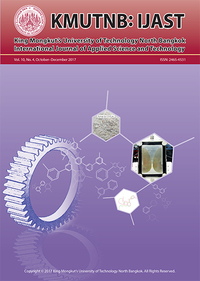Modeling Impacts of Dengue Vaccination on Sequential Epidemics
Main Article Content
Abstract
The efficiency of dengue vaccines in preventing the infection from multi strain dengue virus is crucial for public health prevention strategies. To understand how the vaccine interrupts the transmission cycle between strains is an important task leading to the prevention plan. We use a mathematical model to investigate the impact of vaccine on the subsequent spread of two dengue virus serotypes. The model suggests how to maintain sufficient amount of vaccine coverage to prevent the subsequent epidemics and the effect of vaccine on the interaction between strains.
Article Details
How to Cite
Patanarapeelert, N., & Patanarapeelert, K. (2017). Modeling Impacts of Dengue Vaccination on Sequential Epidemics. Applied Science and Engineering Progress, 10(4), 287–292. retrieved from https://ph02.tci-thaijo.org/index.php/ijast/article/view/186892
Issue
Section
Research Articles
References
[1] World Health Organization, “Dengue, dengue haemorrhagic fever,” Weekly Epidemiological Record, pp. 193–196, 2000.
[2] World Health Organization, Dengue haemorrhagic fever: Diagnosis, treatment, prevention and control, 2nd ed., Geneva: World Health Organization, 1997, pp. 1–23.
[3] A. Nisalak, T. P. Endy, S. Nimmanitya, S. Kalayanarooj, U. Thisayakorn, R. M. Scott, D. S. Bruke, C. H. Hoke, B. L. Innis, and D.W. Vaughn, “Serotype-specific dengue virus circulation and dengue disease in Bangkok, Thailand from 1973 to 1999,” The American Journal of Tropical Medicine and Hygiene, vol. 68, no. 2, pp. 191–202, 2003.
[4] D. J. Gubler, “Dengue and dengue hemorrhagic fever,” Clinical Microbiology Review, vol. 11, no. 3, pp. 480–496, Jul. 1998.
[5] B. Adams, E. C. Holmes, C. Zhang, M. P. Mammen, S. Nimmannitya, S. Kalayanarooj, and M. Boots, “Cross-protective immunity can account for the alternating epidemic pattern of dengue virus serotypes circulating in Bangkok,” in Proceedings of the National Academy of Sciences of the United States of America, Sep. 2006, vol. 103, no. 38, pp. 14234–14239.
[6] D. A. T. Cummings, I. B. Schwartz, L. Bilings, L. B. Shaw, and D. S. Burk, “Dynamic effects of antibody-dependent enhancement on the fitness of viruses,” in Proceedings of the National Academy of Sciences of the United States of America, Oct. 2005, vol. 102, no. 42, pp. 15259–15264.
[7] I. Kawaguchi, A. Sasaki, and M. Boots, “Why are dengue virus serotypes so distantly related? Enhancement and limiting serotype similarity between dengue virus strains,” in Proceedings of the Royal Society B: Biological Sciences, Nov. 2003, vol. 270, pp. 2241–2247.
[8] H. J. Wearing and P. Rohani, “Ecological and immunological determinants of dengue epidemics,” in Proceedings of the National Academy of Sciences of the United States of America, Aug. 2006, vol. 103, no. 31, pp. 11802–11807.
[9] N. Ferguson, R. Anderson, and S. Gupta, “The effect of antibody-dependent enhancement on the transmission dynamics and persistence of multiplestrain pathogens,” in Proceedings of the National Academy of Sciences of the United States of America, Jan. 1999, vol. 96, no. 2, pp. 790–794.
[10] M. Sriprom, P. Barbazan, and I. M. Tang, “Destabilizing effect of the host immune status on the sequential transmission dynamics of the dengue virus infection,” Mathematical and Computer Modeling, vol. 45, no. 9–10, pp. 1053–1066, May 2007.
[11] L. Esteva and C. Vargas, “Coexistence of different serotypes of dengue virus,” Journal of Mathematical Biology, vol. 46, no. 1, pp. 41–47, Jan. 2003.
[12] J. Lourenco and M. Recker, “Dengue serotype immune-interactions and their consequences for vaccine impact predictions,” Epidemics, vol. 16, pp. 40–48, Sep. 2016.
[2] World Health Organization, Dengue haemorrhagic fever: Diagnosis, treatment, prevention and control, 2nd ed., Geneva: World Health Organization, 1997, pp. 1–23.
[3] A. Nisalak, T. P. Endy, S. Nimmanitya, S. Kalayanarooj, U. Thisayakorn, R. M. Scott, D. S. Bruke, C. H. Hoke, B. L. Innis, and D.W. Vaughn, “Serotype-specific dengue virus circulation and dengue disease in Bangkok, Thailand from 1973 to 1999,” The American Journal of Tropical Medicine and Hygiene, vol. 68, no. 2, pp. 191–202, 2003.
[4] D. J. Gubler, “Dengue and dengue hemorrhagic fever,” Clinical Microbiology Review, vol. 11, no. 3, pp. 480–496, Jul. 1998.
[5] B. Adams, E. C. Holmes, C. Zhang, M. P. Mammen, S. Nimmannitya, S. Kalayanarooj, and M. Boots, “Cross-protective immunity can account for the alternating epidemic pattern of dengue virus serotypes circulating in Bangkok,” in Proceedings of the National Academy of Sciences of the United States of America, Sep. 2006, vol. 103, no. 38, pp. 14234–14239.
[6] D. A. T. Cummings, I. B. Schwartz, L. Bilings, L. B. Shaw, and D. S. Burk, “Dynamic effects of antibody-dependent enhancement on the fitness of viruses,” in Proceedings of the National Academy of Sciences of the United States of America, Oct. 2005, vol. 102, no. 42, pp. 15259–15264.
[7] I. Kawaguchi, A. Sasaki, and M. Boots, “Why are dengue virus serotypes so distantly related? Enhancement and limiting serotype similarity between dengue virus strains,” in Proceedings of the Royal Society B: Biological Sciences, Nov. 2003, vol. 270, pp. 2241–2247.
[8] H. J. Wearing and P. Rohani, “Ecological and immunological determinants of dengue epidemics,” in Proceedings of the National Academy of Sciences of the United States of America, Aug. 2006, vol. 103, no. 31, pp. 11802–11807.
[9] N. Ferguson, R. Anderson, and S. Gupta, “The effect of antibody-dependent enhancement on the transmission dynamics and persistence of multiplestrain pathogens,” in Proceedings of the National Academy of Sciences of the United States of America, Jan. 1999, vol. 96, no. 2, pp. 790–794.
[10] M. Sriprom, P. Barbazan, and I. M. Tang, “Destabilizing effect of the host immune status on the sequential transmission dynamics of the dengue virus infection,” Mathematical and Computer Modeling, vol. 45, no. 9–10, pp. 1053–1066, May 2007.
[11] L. Esteva and C. Vargas, “Coexistence of different serotypes of dengue virus,” Journal of Mathematical Biology, vol. 46, no. 1, pp. 41–47, Jan. 2003.
[12] J. Lourenco and M. Recker, “Dengue serotype immune-interactions and their consequences for vaccine impact predictions,” Epidemics, vol. 16, pp. 40–48, Sep. 2016.


